Transforming Conversational AI Generated Chats into a Revisable Knowledge Asset.
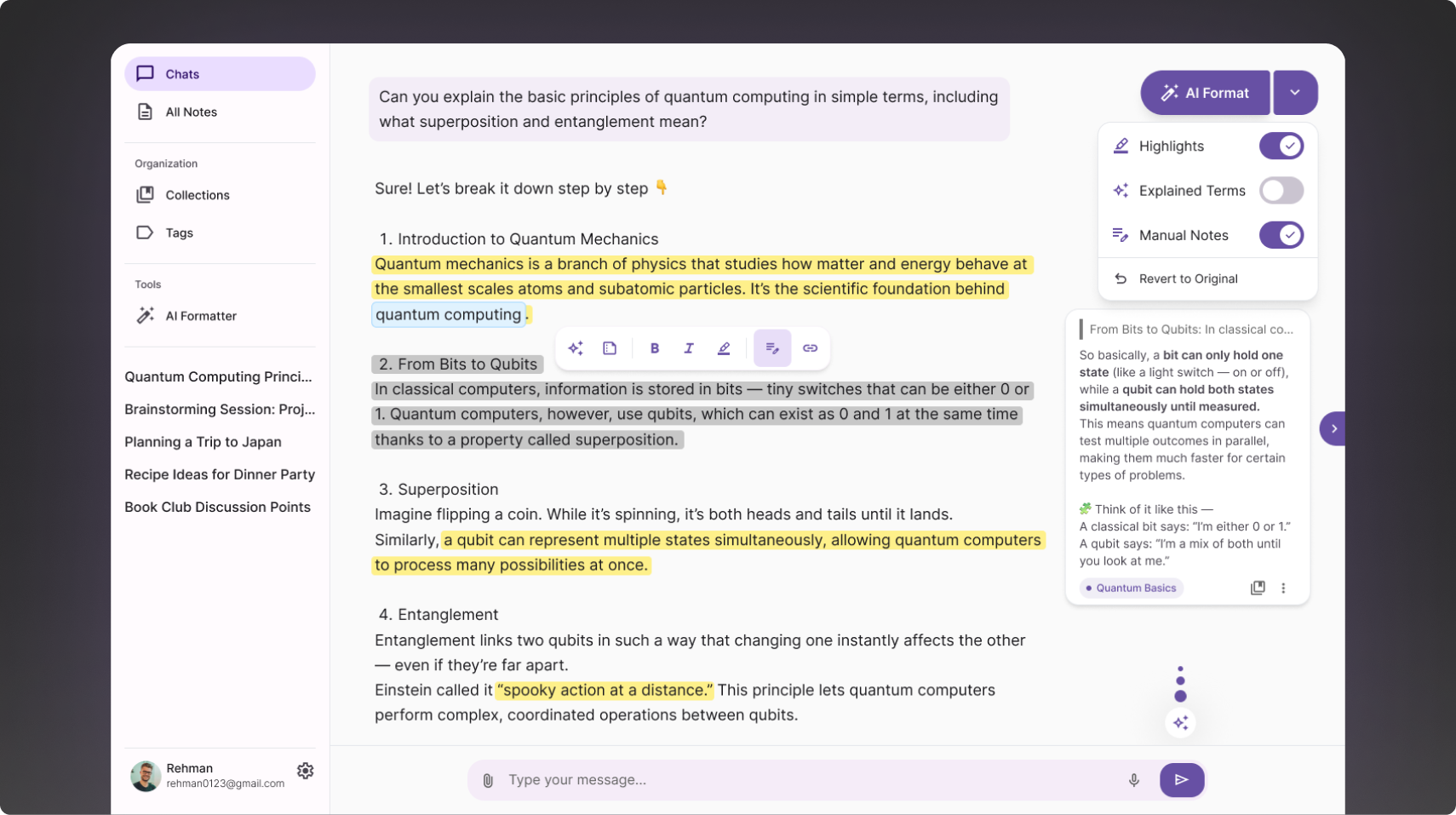
Duration
2 Months
Project Type
Research & Redesign
Contribution
UX/UI Designer, Researcher, Prototype Designer
So people kept learning but never retaining, right?
Imagine using ChatGPT to explore complex topics like quantum mechanics, UX design, or coding only to lose all those micro-learnings the moment you close the chat.
Through observation, it became clear that people didn’t need another notes app they needed a memory layer within their AI experience. Screenshots, copy-pasting, and scattered docs weren’t solving the real need continuity.
The problem wasn’t just about saving it was about making knowledge reusable.
I designed an integrated note-taking experience that lets users highlight, format, and add contextual notes directly within chats keeping their ideas organized and searchable, without breaking the creative flow.
Impact
The Knowledge Organization Solution transformed the GenAI experience from a simple Q&A tool into a powerful, personal knowledge management platform, maximizing the value of every user interaction.
Shifted the user’s role from passive consumer of information to an active processor, leading to deeper knowledge internalization.
Provided the necessary high-level organization (Collections) and granular control (Tags) to manage research across dozens of long-term projects and thousands of notes without structural clutter.
Ensured every piece of high-value knowledge is instantly searchable, bypassing the inefficiency of scrolling through long chat histories to find buried data.
Established accountability and security by providing users with full control over their knowledge through the Note Editor and a robust Version History.
Problem
Most GenAI tools treat learning as temporary conversations vanish, and valuable insights get lost once the chat ends.
But for learners, researchers, and creators, context matters. Notes are the link between curiosity and understanding.
- Highlighting or saving key insights meant switching tools or taking screenshots.
- Losing the flow while trying to copy or organize information.
- No structured way to revisit or build on previous learnings within the chat interface.
Goal
Design an integrated Note-Taking System within Chat based GenAI Tools that allows users to highlight, summarize, and organize knowledge without leaving the chat experience.
- Highlight and format key text (bold, italics, or colored highlights).
- Create and attach contextual notes beside chat content.
- Organize notes into tagged collections for quick retrieval.
- Summarize, explain, or expand on highlighted text directly via the context menu, all without breaking conversation flow.
I explored three distinct directions before arriving at the final solution. Each had potential but only one aligned with user flow and creative behavior.

- Idea 1 - Contextual Knowledge CaptureThis feature introduces a "Save Response" button next to each AI output, enabling users to instantly transfer high-value content to a dedicated "All Notes" tab.
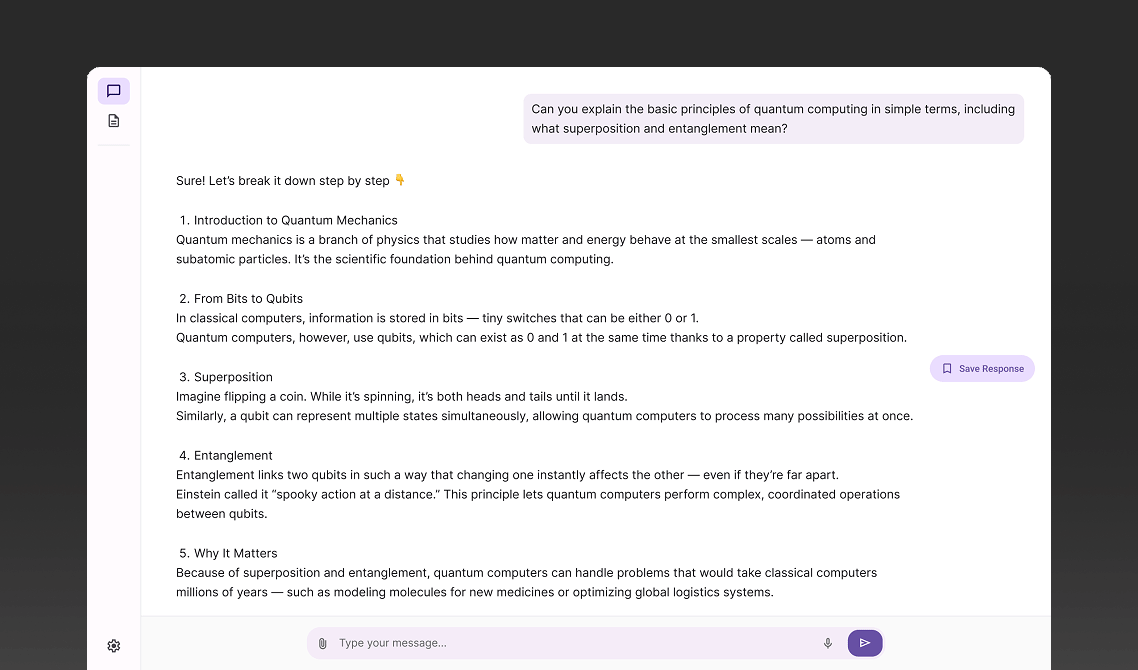 Direct Knowledge Capture: The save button provides a single, immediate action to capture high-value response without manual copy-pasting.Separation of Concerns: The "All Notes" tab effectively separates the curated knowledge from the messy chronological chat history.Poor Retrieval for Future Use: Searching is inefficient as it relies on keywords rather than organized, tagged concepts.No Active Learning Tools: Users cannot easily highlight, summarize, or add notes to the AI's output to build personal knowledge.
Direct Knowledge Capture: The save button provides a single, immediate action to capture high-value response without manual copy-pasting.Separation of Concerns: The "All Notes" tab effectively separates the curated knowledge from the messy chronological chat history.Poor Retrieval for Future Use: Searching is inefficient as it relies on keywords rather than organized, tagged concepts.No Active Learning Tools: Users cannot easily highlight, summarize, or add notes to the AI's output to build personal knowledge. - Idea 2 - AI-Driven Content FormatterThis feature utilizes an "AI Formatter" tool to intelligently identify and visually structure the most critical concepts within chat responses.
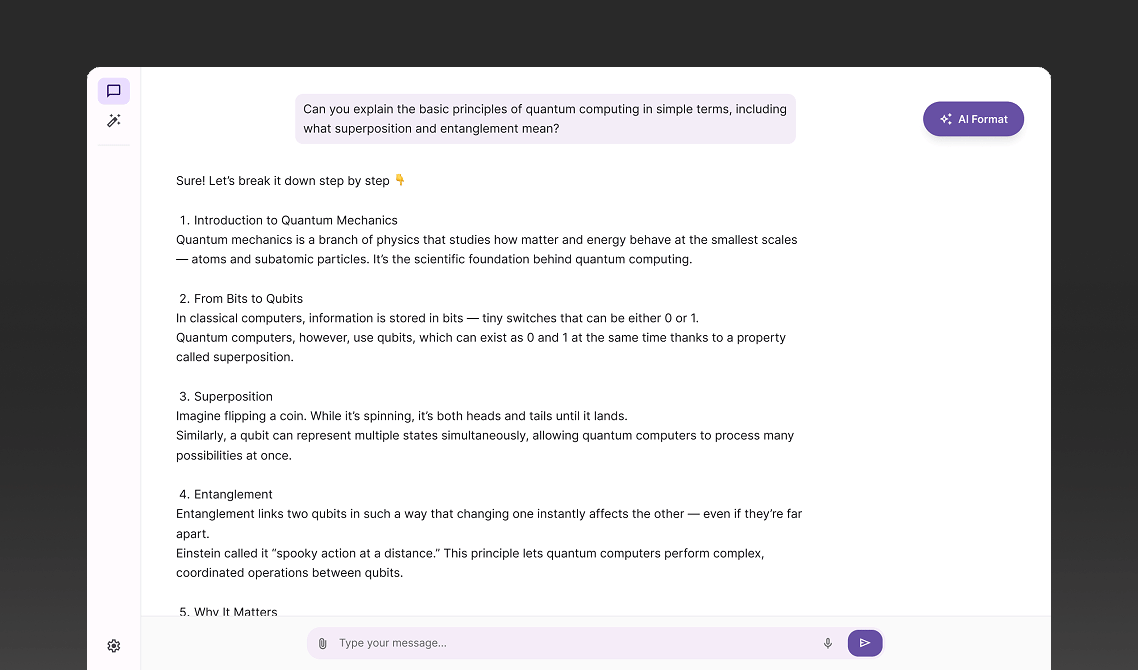 Automated Knowledge Distillation: The AI automatically identifies and highlights the most important concepts, instantly separating the signal from the noise in long responses.Time Savings: Users avoid the tedious manual process of bolding, underlining, and highlighting text, significantly speeding up the note-taking phase.Reliance on AI Judgment: The AI's definition of "key concepts" might not always align with the user's specific research goals or personal interpretation, potentially formatting and highlighting irrelevant text.Lack of Customization: If the user cannot easily edit or adjust the AI's highlighting and formatting, the tool's flexibility is limited.
Automated Knowledge Distillation: The AI automatically identifies and highlights the most important concepts, instantly separating the signal from the noise in long responses.Time Savings: Users avoid the tedious manual process of bolding, underlining, and highlighting text, significantly speeding up the note-taking phase.Reliance on AI Judgment: The AI's definition of "key concepts" might not always align with the user's specific research goals or personal interpretation, potentially formatting and highlighting irrelevant text.Lack of Customization: If the user cannot easily edit or adjust the AI's highlighting and formatting, the tool's flexibility is limited. - Idea 3 - Focus on Active Learning & ReadabilityThis system ensures high-fidelity knowledge retention by blending AI-Explain with manual highlights & notes, supported by persistent floating icons for visibility. The architecture's core strength is its systematic organization, which optimizes content readability and synthesis.
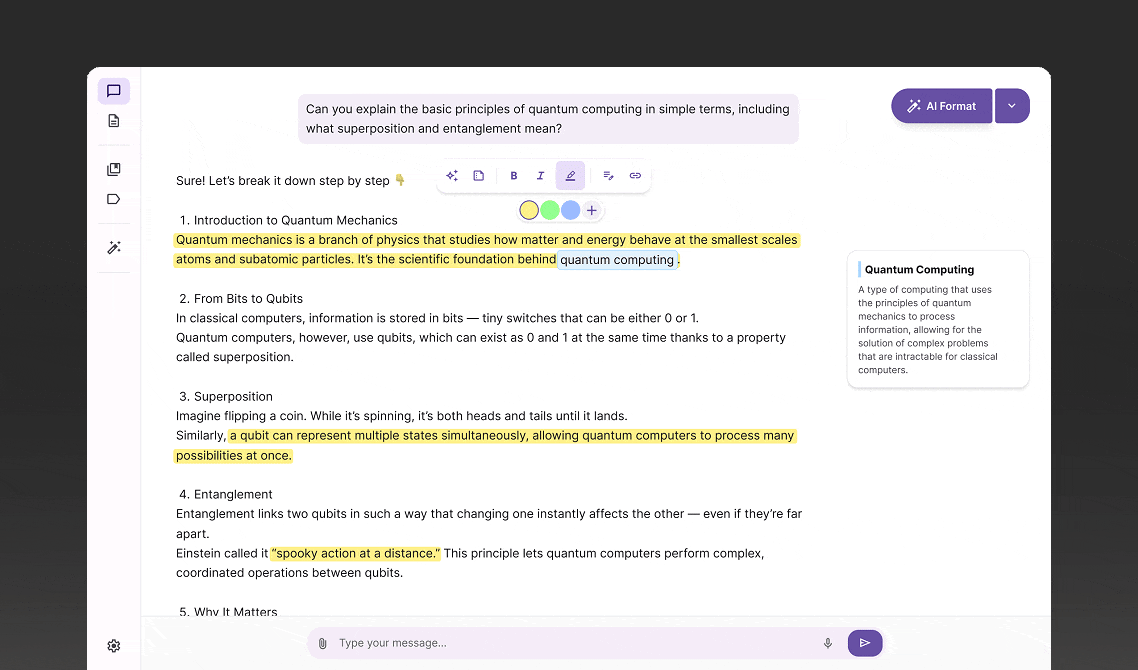 Hybrid Active Learning: The blend of manual highlighting and automated AI Explain features supports deep, personalized synthesis and summarization.Superior Density Control: Independent toggles for Highlights, Explained Terms, and Notes drastically improve revision focus and readability.Flexible Retrieval Structure: The system offers powerful, dual-path access to notes via both global "All Notes" and specific chat history context.Project-Based Knowledge OrganizationThis feature introduces Collections, enabling users to categorize notes and AI-generated concepts into thematic or project-based folders. This provides high-level retrieval and synthesis by isolating project-specific information from the global "All Notes" view.
Hybrid Active Learning: The blend of manual highlighting and automated AI Explain features supports deep, personalized synthesis and summarization.Superior Density Control: Independent toggles for Highlights, Explained Terms, and Notes drastically improve revision focus and readability.Flexible Retrieval Structure: The system offers powerful, dual-path access to notes via both global "All Notes" and specific chat history context.Project-Based Knowledge OrganizationThis feature introduces Collections, enabling users to categorize notes and AI-generated concepts into thematic or project-based folders. This provides high-level retrieval and synthesis by isolating project-specific information from the global "All Notes" view. Project-Based Organization: Collections provide a necessary high-level, thematic container for organizing notes related to specific projects.Targeted Retrieval: Users can efficiently filter notes to view only those relevant to a specific project or research theme.Supports Multi-Chat Synthesis: Notes from different conversations can be centrally gathered under one Collection, enabling cross-project synthesis.Granular Concept ManagementThis feature introduces Tags for detailed, bottom-up organization, this enables advanced retrieval through multi-tag filtering and provides a safety net for all edits.
Project-Based Organization: Collections provide a necessary high-level, thematic container for organizing notes related to specific projects.Targeted Retrieval: Users can efficiently filter notes to view only those relevant to a specific project or research theme.Supports Multi-Chat Synthesis: Notes from different conversations can be centrally gathered under one Collection, enabling cross-project synthesis.Granular Concept ManagementThis feature introduces Tags for detailed, bottom-up organization, this enables advanced retrieval through multi-tag filtering and provides a safety net for all edits.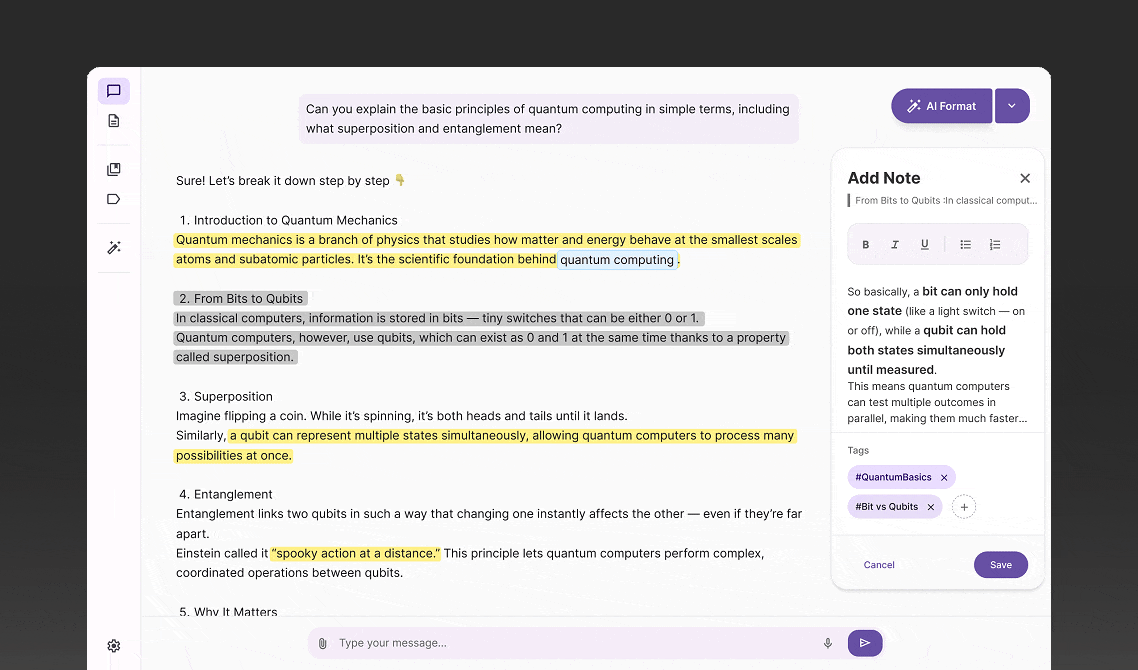 Granular, Concept-Based Retrieval: Tags provide flexible, concept-based organization, allowing users to find notes based on specific terminology.Advanced Synthesis and Filtering: The ability to filter notes using AND/OR logic with multiple tags enables powerful, cross-concept synthesis.User Ownership and Refinement: The Note Editor empowers users to refine the AI's output and add necessary personal context or formatting.Safety and Auditability: Version History provides a critical safety net, allowing users to restore previous states and track knowledge evolution.
Granular, Concept-Based Retrieval: Tags provide flexible, concept-based organization, allowing users to find notes based on specific terminology.Advanced Synthesis and Filtering: The ability to filter notes using AND/OR logic with multiple tags enables powerful, cross-concept synthesis.User Ownership and Refinement: The Note Editor empowers users to refine the AI's output and add necessary personal context or formatting.Safety and Auditability: Version History provides a critical safety net, allowing users to restore previous states and track knowledge evolution.💎 Why the Knowledge Organization Solution Wins:
The solution introduced a multi-layered system for capturing, processing, and retrieving knowledge, empowering users to actively synthesize AI output and integrate it into their long-term research or project workflows.
